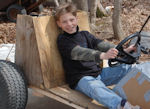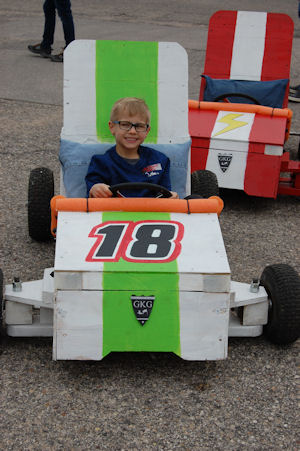Belt drives are an enigma to most people who look at them. They don’t quite understand the semi complexities of the system. It really is not that complex it is just a matter of getting a belt to drive the system without burning it up.
One of the biggest problems you run into is trying to connect the engine to the gearing so that you have decent rpms and you are not stalling the motor.
A belt drive can be intricate subject especially if the system does not have a clutch.
You can have a belt drive system that has a centrifugal clutch.
Or you can run it just a regular v-belt system, that works too.
What we are primarily talking about here, is a V-belt system without a clutch.
Now, what is effectively happening is that the belt is the clutch. Remember a clutch is something that takes away the heat energy and gradually transfers the spinning energy of the engine to the go-kart system. In other words if you engage the clutch you are basically tightening the belt.
As you tighten a belt it grabs. Then the belt is moving. Once you have the belt moving then you have power.
If you do not have the belt system set up right you will be very frustrated and probably end up stalling your engine numerous times.
To tighten the belt there are various systems.
The first system is the distance expansion method, where the center-to-center distance, mainly the engine and the drive system, are brought apart and changed to be longer.
The second system is to uses a tensioner. Both methods are acceptable. The belt tensioner method is the preffered method, because it is simpler and requires less adjustment.
In a tensioner system, basically what we are doing ,as I said before, is we are increasing the tension on the belt with a tensioner pulley. The tension on the belt is increased so that the belt grabs into the pulley and when it is grabbing into the pulley then it engages. It can’t be a sudden grab. So one of the things you have to do is make sure you have some sort of lever arm, foot pedal or something that pulls. This gradually engages the tension, like a clutch, accept it is kind of reverse. Instead of pushing in a clutch to get it to disengage it you are actually pulling on a lever to get it to happen.
The preferred method , and I want to stress this is that the clutch should disengage when no forces is put on it. In other words, when the engine is at idle it obviously should be disengaged. And the default setting should be that the engine is idling with the clutch disengaged There is no neutral here. You have to pull the clutch out of position. To have that happen you either flip a lever down which, engages the belt tentioner, or you push on the foot pedal.
But the idea when you let go of the foot pedal (ie you flip off the go-kart or you fall off the go-kart, or you’re just starting it) the clutch is disengaged. The key here is safety. You want to make sure that no one is going to get hurt. The thing doesn’t fire up when your in gear or when you start it up.
So to get the system to activate, on a slider mechanism, you either have to have a cranking mechanism to pull the engine on a slider or push it away. It causes the belt to get tighter. So you have the engine mounted on a pad with hinges on it so that when you crank, it pushes the engine into the air to tighten the belt, or it moves on the slider hinge and cause it to tighten the belt.
The center-to center distance is the nicest version to use, if you are using the twisted belt system In other words you are using a vertical engine. A vertical engine, as you know are not the prettiest systems. They can be a little complex. You need a jack shaft, more than likely, with the systems to get them to work well.
But if you are choosing to use the twisted belt drive system, then the center-to-center distance is the preferred method. Trying to get a belt tensioner on a twisted belt system is actually kind-of difficult. You actually have to mount the tensioner at an angle. If you do not have it just quite right it might not work properly. You have to worry about tracking the belt and so on.
If you look in the guide, I have a set-up-system showing how you put a twisted belt system together. You need to have shrouds around the engine pulley and driven pulley. So that when the engine’s center-to-center distance is lessened, the belt is loosened and that the belt does not just flop off and fall on the ground, it actually falls onto the shielding.
Now the shielding has to be quite close to the pulley; just enough that when the engine is spinning it is not actually grabbing the belt but sits there and spins. That’s the ideal. And then when you tension it, then it tightens around that. We are not going to go in to go into all the details about what size engines and all that, we are just going into the drive systems of the belts.
Now that is the preferred method for a twisted belt drives. You can if you to want to use a clutch on a twisted belt drive on the engine, if you want. That is fine it works too.
As far as getting the twisted drive to work, you need to get your calculations first. You need to understand what kind of torque is going to be put in there and with the engine if you’re actually going to get the right amount of torque.
Now if you have a ten horsepower motor you might not have to worry about it that much and lug right through it. I know I had a 3 ½ horse power motor that I was playing with and kept stalling it. Really what was required was we needed to have close to 10 to 1 ratio for the dumb thing to work. 3 ½ horsepower does not have the torque that is required to get it to happen at a low, low speed especially during an engagement.
So it would be wise to do your calculations first because you might end up being disappointed if you got this motor that can spin quite fast but you can only go about 5 mph because of there is no torque that can actually be put out by the motor. Now you can get past that by putting a clutch system in there. That might buy you some more speed, because the engagement process is over various rpm. Not just when you engage it ‘bam!’ it is ‘ON’. It has no choice but to go. At least with a centrifugal clutch it does not have to grab right away.
Belt drives are quite possible, that is what I am saying. That is your option. The advantage of the belt drive it is not as dirty as a chain. You do not have to lubricate it. It can handle the elements better. There are some downs if the belt gets wet, or if it gets oil on it will slip more.
Do not think you can use slippage (ie oiling or wetting the belt) at your advantage. I tried that. Your belt will just slip, and that gets quite frustrating. Then you have to tighten the belt really hard to get it to do any thing. Really what happens is you have to burn the oil out of it so it can grab. So do not think that adding oil to the belt to increase your performance. It is not! In the long run it is just going to add frustration.
The best thing to do, is to do your calculations. Go to the Go-Kart Guru Engineering Tools page. On there is the performance program. You can put in the data that you are desiring.
For instance your pulley sizes. Basically what you need to do is throw in teeth sizes. Then it will calculate what the pulley sizes are. Then you match up your pulley sizes from there. So if you just start throwing in the sprocket sizes to match the pulley sizes pitch diameters and you just keep pressing ‘calculate’ until you get the diameter you want. Do not worry about the diameter data that is being put out. Just keep putting in the numbers and stuff until you get what you want on or the diameters which are realistic.
Let us say you got a 1 ½ inch pulley and you have got a 4 inch that you are driving. Those are the two pulleys that you put in there: one for the drive gear on the engine, and one for the driven axel.
Now say you have a reduced system, a jackshaft system. (I may end up writing a program, I have not done this yet, where it would includes jackshafts. It would help people.) The bottom line is that the to figure out jackshafts you just figure out the ratios. You have got one ratio from the engine the jackshaft. Then you have the ratio from the jackshaft to the driven gear. You multiply those two together to get the number at your final ratio. The program actually puts in the ratio at the bottom. So you just observe what that ratio is, and keep cranking in the numbers.
I do have on a page how to work through jackshafting calculations. There is a formula (again this is in my how to build my go-kart pdf) if you are interested in that, there are details on how to calculate that by hand. The short rule is just pick the two ratios and multiply by each other and that is your finale ratio. So say you have got a 2:1 ratio to your jack shaft and then you have got a 4:1 ratio to a the drive gear from the jack shaft. You multiply the two together and you have got an 8:1 ratio.
Then you figure out what your engine is actually going to be able to handle. You want the engine to be able to deliver the power. The program will give you some expectations of what will happen. If you go to the performance site you know what to expect from an engine, there is an article on “Is my engine big enough for my go-kart or is it too small for my go-kart?”.
Belt drives are very possible. The belt drives require tension that is the key to understand if you loose tension you will loose power. Also the second thing to understand is that it must be disengaged when the engine is in idle. When you want to first start it has to be disengaged.


